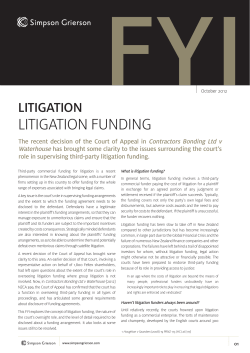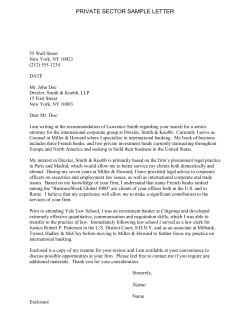
Lis Pendens: When can a Lis Pendens be registered? Group Briefing
1 | arthur cox Group Briefing May 2013 key contacts For further advice on litigation and enforcement, please contact:- Eve Mulconry Partner +353 1 618 0455 eve.mulconry@arthurcox.com Anna Morgan Senior Associate +353 1 618 0412 anna.morgan@arthurcox.com This document contains a general summary of developments and is not a complete or definitive statement of the law. Specific legal advice should be obtained where appropriate. litigation & dispute resolution Lis Pendens: When can a Lis Pendens be registered? The term lis pendens is the Latin for “litigation pending” and refers to a legal burden registrable against land which is the subject of litigation in the Circuit or High Court. That litigation must involve a claim made or disputed by one of the parties to an interest or estate in the land in question. Registering a lis pendens will seriously restrict the manner in which the land concerned can be dealt with. As the procedural threshold for registering a lis pendens1 is much lower than that for vacating it, there is also considerable scope for abuse of this mechanism. However a recent Supreme Court decision demonstrates that a plaintiff will not be permitted to manufacture a claim to an interest in land solely to satisfy the criteria necessary to register a lis pendens. and incurs minimal costs, the consequences for the affected party can be serious. The purpose of a lis pendens is to put third parties on notice that there is ongoing litigation over a property which could ultimately diminish its value or affect the interest of the party currently holding or controlling it. Potential purchasers will generally be reluctant to proceed with a sale where they discover that a lis pendens is registered. A lis pendens therefore prevents the person holding the property from dealing with it in the usual course, effectively freezing their rights of disposal. These adverse consequences are exacerbated by the necessity to make a Court application (unless the registrant consents) to vacate the lis pendens. Potential for Abuse Registration and Effect The registration of a lis pendens can be easily achieved, without any sanction from the Court, through the lodgement of an application form and the issued summons or civil bill (which does not need to have been served) in the Central Office of the High Court. While registration is generally uncomplicated The imbalance between the administrative process for registering a lis pendens and the Court application required to vacate it means that this device can be abused. In an application to vacate a lis pendens the Court will adjudicate on whether the registration criteria stipulated in the 2009 Act2 is satisfied. Notably no such judicial 1 Set out in the Land and Conveyancing Law Reform Act 2009 (the “2009 Act”) 2 Section 121(2) sets out the types of action which may be registered as lis pendens 2 | arthur cox litigation & dispute resolution lis pendens: when can a lis pendens be registered? examination is required prior to the lis pendens being registered. lis pendens was preventing the sale from proceeding, IBRC brought an application to the High Court under the 2009 Act to vacate the lis pendens. Section 123(b)(ii) of the 2009 Act provides for the Court to vacate a lis pendens on the application of a person affected by it where it is satisfied that the action is not being prosecuted bona fides. contention in its ex tempore judgment. It confirmed that the party affected by the registration of a lis pendens may apply to vacate it when he becomes aware of it and there is no obligation to await the delivery of the Plenary Summons and Statement of Claim before doing so. However, the recent case of Kelly & O’Kelly v. IBRC Limited3, demonstrates that there must be a genuine claim to an interest in a property in order to register a lis pendens against it. The High Court and Supreme Court judgments confirm that where a claim has been articulated solely to enable the registration of a lis pendens, such registration will have been effected in an absence of good faith and will be vacated by the Court. Kelly & O’Kelly v. IBRC The Kelly & O’Kelly case concerned a residential property in Killiney, County Dublin (the “Property”) which was mortgaged to Irish Nationwide Building Society (“INBS”) and thereafter, to its successor, Irish Bank Resolution Corporation Limited (“IBRC”). An Order for possession of the Property was obtained by INBS with the consent of the Plaintiffs in June 2010. IBRC executed the Order and recovered possession of the Property from the Plaintiffs in April 2012. In July 2012 the Plaintiffs issued proceedings against IBRC for a number of reliefs including damages for slander of title to goods and property and trespass to land in respect of the Property. A declaration was also sought that the Order for possession was in breach of contract, void or invalid. On the same date that those proceedings were issued, a lis pendens was registered against the Property. However the proceedings were not served and notice of the lis pendens was not given to IBRC, which became aware of both from its own enquiries. As IBRC had reached an agreement to sell the Property to third parties and the 3 [2012] IEHC 401 arthurcox.com The High Court found that because the Plaintiffs were unable to articulate any detail or basis for advancing a claim to an interest in the Property, this was fatal and confirmed an absence of bona fides in registering the lis pendens. Mr Justice Ryan held that the claim for declaratory relief in respect of the Order for possession had been “..introduced for the sole purpose of providing a colourable justification for registering a lis pendens in the hope of frustrating a sale of the property.” Ordering that the lis pendens be vacated and the claim for declaratory relief against the Order for possession be struck out, Mr Justice Ryan concluded that: “..there is nothing in the materials put before the Court or in any submission made by Counsel… to suggest any legitimate basis for registering the lis pendens. It would be a clear injustice to permit the processes of the Court to be employed for the purpose and only for the purpose of frustrating the exercise of legitimate rights. That would be the case here if the lis pendens were permitted to remain”. The Plaintiffs appealed and argued that the application to vacate the lis pendens was premature because they had not had a chance to make their case and IBRC should have awaited delivery of the Plenary Summons and Statement of Claim before bringing the application. The Supreme Court rejected this Approving the High Court judgment, the Supreme Court acknowledged that there are many cases where it is important in the interests of justice that a plaintiff is entitled to register a lis pendens and that it was not a discreditable or suspicious thing to do so. However it was important that when a lis pendens was registered without substantial grounds, as was the case here, the affected party has an entitlement to apply to set it aside. Commentary The case confirms that the registration of a lis pendens must be founded upon a genuinely held claim to an interest in land. Anything short of this will amount to an absence of bona fides justifying the lifting of the lis pendens. Usefully, the case is also authority that the affected party may bring an application to vacate a lis pendens even where the proceedings in question have not yet been served. While the Court will not permit a lis pendens to be used to frustrate the legitimate rights of another party, invariably such a determination cannot take place until after registration. As noted by the Supreme Court, a lis pendens can be registered for the price of the stamp duty and the effective result is to sterilise the property concerned. Meanwhile, the fact remains that considerably more time, effort and expense is required to vacate than to register a lis pendens. Dublin +353 1 618 0000 dublin@arthurcox.com London +44 207 823 0200 london@arthurcox.com Belfast office +44 28 9023 0007 belfast@arthurcox.com New York +1 212 782 3294 newyork@arthurcox.com Silicon Valley +1 650 943 2330 siliconvalley@arthurcox.com
© Copyright 2025

















